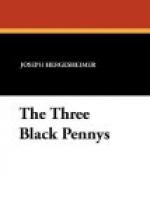XXXI
James Polder conducted them to the river, sweeping away in a wide curve beneath solid grey stone bridges into a region of towering hills. They turned to the left, and, walking on a high embankment, passed blocks of individually pretentious dwellings, edifices of carved granite, alternating with the simpler brick faces of an older period. A narrow, whitely dusty sweep of green park was followed by a speedy degeneration of the riverside; the houses shrunk to rows of wood marked by the grime of steel mills. Soon after they reached a forbidding fence; and, passing a watchman’s inspection, entered into a clamorous region of sheds, tracks and confusing levels such as Howat Penny had viewed from the train.
“I’m in the open hearth,” Polder told them, leading the way over a narrow boardwalk, still skirting the broad expanse of the river. “It’s a process, really, but the whole mill is called after it. We make steel from iron scrap; that’s our specialty in the Medial Works; and our stuff’s as good as the best. The bigger concerns mostly use pig. Turn in here.” They were facing the towering end of an iron shed, and mounted a steep ascent to gain the upper entrance. The multiplication of noises beat in an increasing volume about Howat Penny. Below him a locomotive screeched with a freight of slag; beyond was a heap of massive, broken moulds; and a train of small trucks held empty iron boxes beside an enormous bank of iron scrap dominated by a huge crane swinging a circular magnet that dispassionately picked up ton loads and bore them to the waiting cars.
Inside he gazed through a long vista under a roof lost in tenebrious shadow. On one side were ranged the furnaces, a continuous bank of brick bound in iron; each furnace with five doors, closed with black slides in which a round opening emitted an intolerable, dazzling white glare. But few men, Howat thought, were visible in proportion to the magnitude of the work; deliberately engaged, with leather shields hanging from their wrists and blue spectacles pushed up on their grimy brows.
A crane advanced with the shrill racket of an electric gong, its operator caged in midair, and herculean grappling chains swinging. A grinding truck, filling the width of floor, moved forward to where Howat stood. It was, Polder told him, the charging machine. An iron beam projected opposite the furnace doors, and it was locked into one of the charging boxes, filled with scrap metal, standing on the rails against the furnaces. A man behind him dragged forward a lever, the slide which covered a door rose ponderously on a blinding, incandescent core, and the beam thrust forward into the blaze, turning round and round in the emptying of the box. It was withdrawn, the slide dropped, and the machine retreated, its complex movements controlled by a single engineer at crackling switches where the power leaped in points of light like violets.




